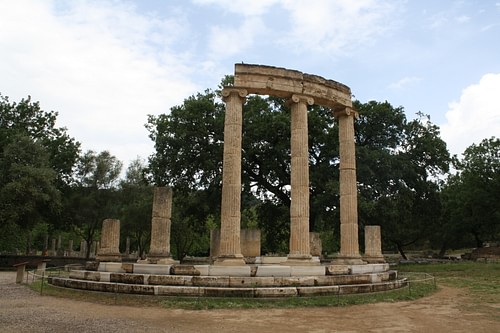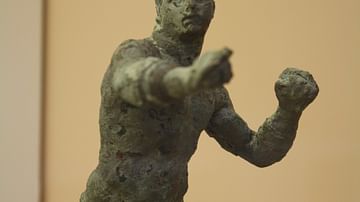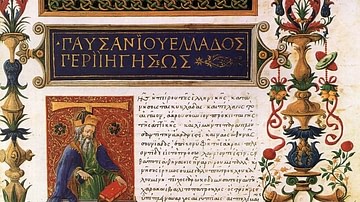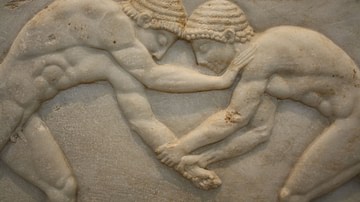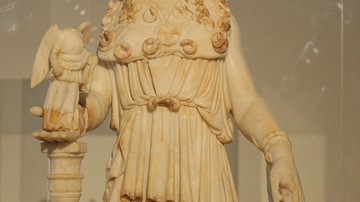
Ancient Olympia was an ancient Greek sanctuary site dedicated to the worship of Zeus located in the western Peloponnese. The Pan-Hellenic Olympic Games were held at the site in honour of Zeus every four years from 776 BCE to 393 CE. Olympia is listed by UNESCO as a World Heritage Site.
Early History
First inhabited in the second millennium BCE, the first archaeological record of dwellings dates from 1900 to 1600 BCE. The Kronion hill at the site was perhaps the first place of worship, dedicated to Kronos. However, other sacred buildings at the foot of the hill in the sacred grove of wild olive trees, or Altis, indicate other deities were worshipped such as Gaia, Themis, Aphrodite, and Pelops. With the descent of western Greek tribes into the Peloponnese, though, it was Zeus, father of the Olympian gods, who would become the dominant cult figure at Olympia.
Temple of Zeus
The first large building at the famous ancient sanctuary site was the Heraion, a temple dedicated to Hera built around 650-600 BCE. In the 5th century BCE the sanctuary reached its peak of prosperity, and the massive 6 x 13 column Temple of Zeus was completed in 457 BCE in order to house a huge ivory and gold statue of the leader of the Olympian gods. Designed by Libon of Elis, the Doric temple was the biggest in Greece at that time and measured 64.12 m x 27.68 m with columns 10.53 m in height. The pediments of the Temple of Zeus displayed magnificent sculpture: on the east side the mythical chariot race between Pelops and Oinomaos, and on the western pediment a Centauromachy with the majestic central figure of Apollo. Metopes from the temple represented the labours of Hercules. The statue of Zeus within the temple was by Phidias (who had worked on the Parthenon and its statue of Athena) and was a 12 m high gold and ivory statue of Zeus seated on a throne and regarded as one of the Seven Wonders of the Ancient World.
Other important building projects over the centuries included baths and a swimming pool (5th century BCE), the new stadium with embankments for spectators (mid-4th century BCE), a palaistra (3rd century BCE), a gymnasion (2nd century BCE), hippodrome (780 m long), the large Leonidaion or guest houses (330 BCE), and the Theikoloi (priest's residence).
The Olympic Games
Sporting events were originally associated with funeral rituals, for example, the funeral games instigated by Achilles in honour of Patroklos in Homer's Iliad. Some mythological accounts credit Zeus with beginning the Games to celebrate his victory over Kronos; other accounts state Pelops began them in honour of Oinomaos. In any case, sport, a healthy body and the competitive spirit were a large part of Greek education, and so it is hardly surprising that organised athletic competitions would at some point be created.
The first Olympic Games were held in 776 BCE at the first full moon after the summer solstice. The winner of the first and only event, the stadion foot-race (one length of the stadium track, 600 feet or 192 m), was Koroibos of Elis, and from then on every victor was recorded and each Olympiad named after them, thus giving us the first accurate chronology of the Greek world. During a three-month Pan-Hellenic truce, athletes and as many as 40,000 spectators came from Greek cities all across the Mediterranean to participate in the Games. Individuals and city-states brought offerings to Zeus which included money, statues (including the magnificent Nike of Paionios, c. 424 BCE, and the Hermes of Praxiteles, late 4th century BCE), bronze tripods, shields, helmets, and weapons resulting in Olympia becoming a living museum of Greek art and culture. Many cities also built treasuries - small but impressive buildings to house their offerings and raise the prestige of their city.
Over time other events were added to the Games such as longer foot-races, wrestling, boxing, chariot racing, discus, javelin, jumping, and the pentathlon. At its peak there were 18 events spread over five days. However, it was always the original stadion which remained the most important event. Victors won crowns of olive leaves and an olive branch cut from the sacred grove, but much more importantly they won glory, fame, and in a very real sense historical immortality.
A second important event held at Olympia was the Heraia Games for women, held every four years in honour of the goddess, Hera. Children, adolescents, and young women ran in separate foot-races over 500 feet of the stadium track (160 m). Prizes for victors included olive crowns and the right to set up a portrait of themselves on the site. The responsibility for the organisation of both Games and for maintenance of the site when not in use lay with the Eleans.
The Games continued through the Hellenistic period with the notable architectural addition of the Philippeion, a circular colonnaded building erected by Philip II of Macedonia which contained gold statues of the royal family (c. 338 BCE). The Romans, whilst giving little importance to the religious significance of the Games, continued to hold them in high regard and despite the attempt by Sulla in 80 BCE to permanently move the Games to Rome, continued to embellish Olympia with new buildings, heated baths, fountains (notably the Nymphaion of Herodes Atticus, 150 CE), and statues. Most famously, emperor Nero strove to win the glory of Olympic victory in 67 CE, competing in, and unsurprisingly winning, every event he entered.
Decline
With Emperor Theodosios' decree to prohibit all cult practices and pagan festivals, the Games came to an end in 393 CE after a run of 293 Olympics over more than a millennium. The famous sanctuary site gradually fell into decline, was partially destroyed under the decree of emperor Theodosios II in 426 CE, and was taken over by a Christian community who built a basilica on the site in the early Byzantine period. Earthquakes in 522 and 551 CE destroyed much of the remaining ruins, and silt from the nearby rivers Alpheios and Kladeos eventually covered the site until its rediscovery in 1829 by the French Archaeological Mission and systematic excavation by the German Archaeological Institute from 1875. Most of the once-fine temples are now mere ruins but the visitor can at least today run along the track of the very first Olympic stadium.
